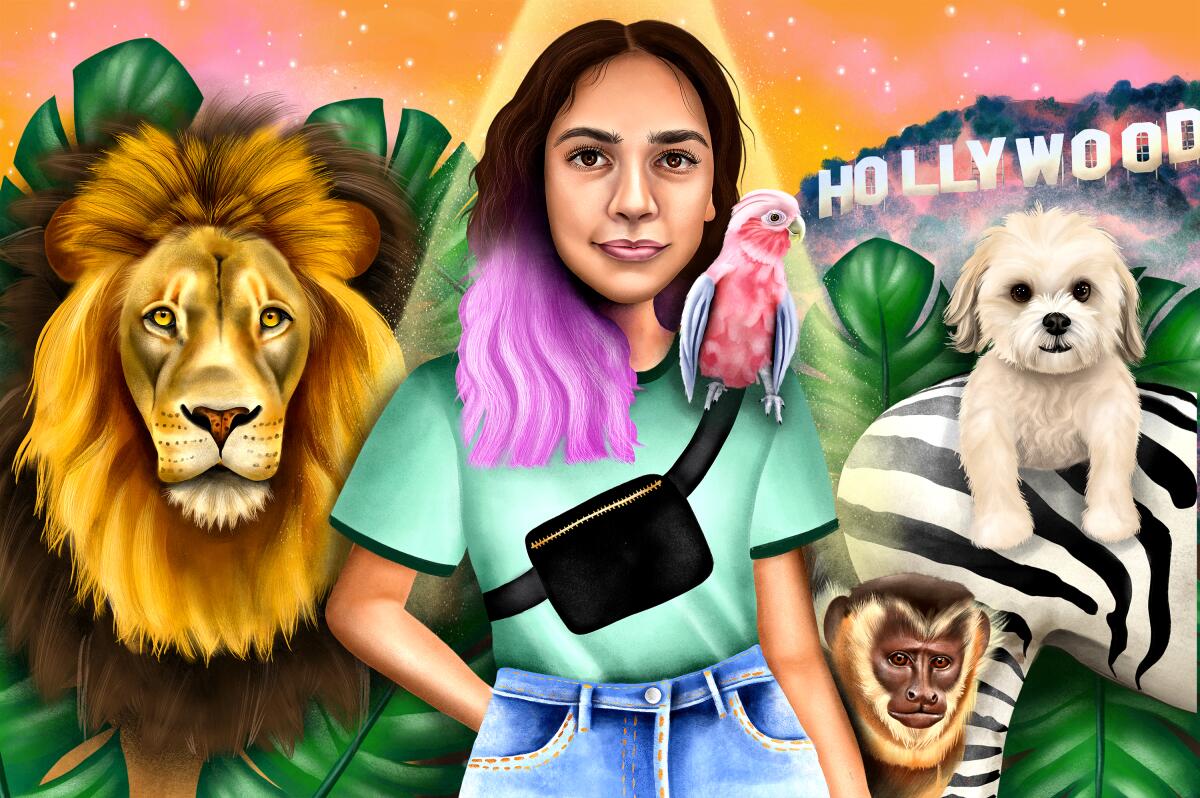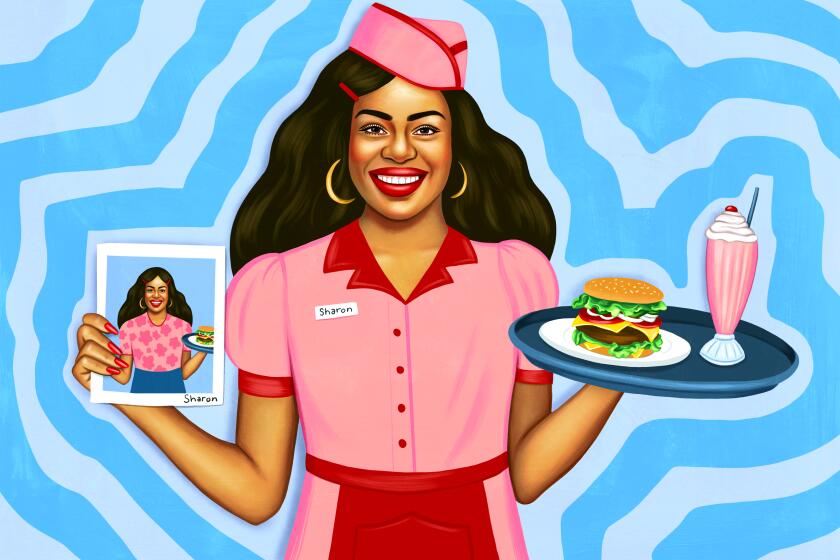Explaining Hollywood: How to get a job as a Hollywood animal trainer

The sounds of lions roaring outside her trailer in Acton, Calif., lulled Ursula Brauner to sleep.
That was in 1986, and Brauner was a recent graduate from the Exotic Animal Training and Management program at Moorpark College. Her trailer was on the grounds of an animal training facility; her trailer-mates were a baby kangaroo and chimpanzee.
Brauner went to Acton to try to break into the entertainment industry, volunteering her time, as so many others starting out do. But instead of making coffee runs, she was cleaning kennels and rearing baby animals. Brauner said she often found herself finishing her chores early so she could watch her more experienced colleagues as they trained animals, absorbing everything she could.
Her first chance to work on a movie set came when a job opened up that required an animal she’d been working with. She never looked back. Today, Brauner is the co-owner of Animals for Hollywood, an animal training facility that’s coordinated animal filming and stunts for more than three decades.
And while each person’s experience is as unique as a zebra’s stripes, here are some tips that Brauner and two other trainers, Karin McElhatton and Sarah Clifford, agree can help you to become an animal trainer in Hollywood.
Who becomes a Hollywood animal trainer?
A deep passion for animals, filmmaking and challenging situations are all traits Brauner said you should have to pursue a career in this field.
Clifford is a good example. An animal lover from a young age, Clifford had thought about becoming a veterinarian. As she got older, though, she found she was drawn to the film industry. So while she was studying media communication at Cal State Sacramento, she took a summer off and began working as a production assistant on movie sets in Southern California.
It was when a murder of crows swarmed the set of “The Matrix Reloaded” on cue that she had her “lightbulb moment.” Thoroughly impressed with how the animal trainers maneuvered on set, Clifford decided to try doing what they did.
One other useful trait is adaptability. Each day is different, which is what makes the field exciting, said McElhatton, owner of Studio Animal Services. There is no set schedule or routine when working with animals. Just like people, Clifford said, each animal has its own personality, requiring adjustments in training and handling.
Most trainers specialize in working with certain animals. Clifford broke into the industry as a dog specialist but has grown her Rolodex over the past two decades. McElhatton said that trainers are given roles on a set based on their experience with specific types of creatures. For example, she said, if one trainer works often and well with tabby cats, and the project calls for that, then that trainer will be brought in.
Finally, animal trainers need to know their way around a film shoot. Brauner said she regularly works with other departments on set to prepare the animals for their scenes. For example, she works with the props department to make sure her animals are comfortable around the props so they’re not distracted or distressed when it comes time for filming.
Because of this, both Brauner and Clifford said a general understanding of how films are made is crucial. Becoming a production assistant, Clifford said, was the best decision she made for her career as an animal trainer.
For many people who pursue entertainment as a career, it takes years to get yourself to where you are making money from your creative work. For making money in the meantime, there’s always waiting tables. But more and more people are turning to platforms like TikTok, Twitch and Patreon.
How do you get started?
According to McElhatton, the first step to becoming a commercial animal trainer is having “a solid animal background.” It doesn’t have to be training related, she said, but rather exposure to and experience with animals.
After her epiphany on the “Matrix” set, Clifford began to research a career in commercial animal training. She wasn’t able to afford the program at Moorpark College, though, so she volunteered at an animal training company to gain experience. (In fact, all three of the professionals interviewed for this piece began as volunteers.)
Some training companies require employees and volunteers to complete the Moorpark program, but not all do. Clifford never attended and now runs her own animal training business, Animal Savvy.
On the other hand, the program has connections with other companies that can help you get into the field sooner, as it did for Brauner.
Because Clifford didn’t go to Moorpark, she said, she was passed over for several volunteer opportunities at commercial animal training companies. So she began doing her own research and teaching herself animal training skills. She brought a mutt home from the shelter and began training him. With a little more experience under her belt, she returned to the same companies that had told her “No” before and finally caught a break.
“He was my ticket in,” Clifford said about her rescue dog, Kuma.
It’s worth noting here that commercial animal training differs from obedience training.
The two disciplines do intersect, and many of the basics of obedience training — such as persuading a dog to sit, speak or shake hands — are necessary for commercial animal trainers to know. But being good at training such skills isn’t enough to make you a good trainer for film work, Brauner said.
That’s because the skills needed on set are distinct.
To get an animal ready for film or television, trainers have to make sure their charges know how to hit their marks, ignore distractions, mirror human behavior and perform tricks and stunts before they even step foot — or paw — on set. Training animals with a clicker, a commonly used method for working with animals that is considered more humane than other techniques, and with positive reinforcement are the industry standard, Clifford said. Being comfortable with these methods, she said, is a huge boost when looking for an opportunity in the field.
Although having experience working with animals of your choosing may help you get a leg up, Brauner said, working with professionals at a facility devoted to training animals for gigs on camera is still the best way to learn the skills needed on a set.
Most new animal trainers do volunteer work as their first step, starting the same way Brauner did: cleaning kennels and helping where an extra pair of hands is needed. She said that if you’re hoping to make it as an animal trainer, you have to pay your dues.
“We have this saying that if you can’t be excellent at maintenance and husbandry care of the animals, you can never be a good second or first trainer,” Brauner said.
Once you start becoming more comfortable around the animals — and the lead trainers see that — you might be asked to come onto set and help, Brauner said. But each person’s trajectory is different, she said. Some will wait only a few months before they’re asked to come to a set. For others, it takes a few years.
There’s one other significant requirement for people getting into the field: compliance with federal and state animal welfare laws. For starters, people who train dogs, cats, horses or other warm-blooded animals for film or TV fall under the federal Animal Welfare Act, which sets standards for animals’ care, feeding and working conditions. Federal rules also require anyone who maintains more than eight animals for exhibition to get a license from the U.S. Department of Agriculture’s Animal and Plant Health Inspection Service.
Even with those rules in place, controversies have erupted over how animals were treated on some sets, such as when the death of three horses led to the cancellation of HBO’s racetrack drama “Luck” in 2012. Some animal rights activists have clashed with the American Humane Assn., which runs the animal-safety inspection and certification program that’s widely used by film production companies.
The first step in your Hollywood career shouldn’t be paying L.A. rent. Here’s how to take your first steps toward a career in the entertainment industry, according to experts.
What are the career paths?
There can be a hierarchy among the trainers on a set. The size of the production and the number of animals required determines the number of trainers on the job, Clifford said. For most there’s a first and second trainer.
First trainer, Brauner said, acts as the coordinator and overseer of the animals. The second trainer helps with whatever the lead trainer needs. Subsequent trainers are assigned specific roles.
As you start working your way up into lead trainer roles, that’s when you can start thinking about launching your own animal training company.
Brauner, along with co-owner David Allsberry, took over Boone’s Animals for Hollywood (now just Animals for Hollywood) when the original owner retired. They’d both volunteered and worked for the company for quite some time before making the move to take over.
Running your own animal training facility comes with a major responsibility: assembling and caring for a roster of animals.
McElhatton said she owns several different types of animals, including about 25 dogs. But when she’s hired for a film or TV show, she doesn’t work solely with those animals. Sometimes a project will call for an animal she doesn’t have, she said, so she has to contract with other training facilities or individual animal owners.
Actors who have chosen to pursue Hollywood later in life as a second career share their experiences and advice.
How do you make money? (And what kind of money?)
Animal handlers and trainers are represented by the Teamsters union. So on productions covered by a Teamsters contract, trainers can make $39 to $55 per hour, depending on the type of animal and the nature of the production, with an eight-hour daily minimum.
Unless you’re on an active production’s payroll, however, you’re not making any money. All the extra hours trainers take to perfect their own and their animals’ skills comes out of their own pockets. Sometimes on projects with bigger budgets, trainers will be compensated for prep time, Clifford said, but that’s not guaranteed.
That’s why interns and volunteers typically are not compensated, Clifford said. “I’m not getting paid either,” she said.
Not all film projects have animals written into them. Out of 10 scripts presented to a studio, Clifford estimated, maybe only one to two have a need for animals. And with more than 100 animal training facilities in the greater Los Angeles area, competition can be stiff. That’s why, she said, working grueling hours to make sure your animals are the best is so important — it will help you win the battle for studio contracts.
All three trainers agreed that another source of income is crucial at the beginning of your career. Without it, you might not be paid for years.
But just because you’re not being paid doesn’t mean the animals’ needs go away. When productions shut down, Clifford said, she had to scramble to figure out how she was going to feed more than 50 animals.
“You’ll never have a day off,” she said.
Despite the long hours, spotty pay and daily challenges, all three said the sacrifices have been more than worth it to them.
“If you’re happy that you’re doing it, that’s part of the reward,” McElhatton said.
You’ve seen TikTok, Instagram and YouTube launch people into Hollywood stardom. Here are some tips for getting started as a social media influencer or creator.
How is this career different than it was 10 or 25 years ago?
McElhatton got her start in animal training with exotic animals. Today, most of those animals are digitally rendered, narrowing the field and increasing competition among training companies.
The advent of broadband has also made it possible to find instruction online. YouTube videos showing animal training techniques are a great way to gain exposure to and experience in the craft, Clifford said. But she added that it won’t replace what you can learn from working hands-on with the animals.
What advice do pros always hear that is wrong?
While working with animals may seem like heaven to some, Clifford said the career itself can be very challenging.
“It’s not for everybody,” she said. “It’s hard to make a full-time career out of it.”
Clifford remembers being told that she had to become a production assistant. And while that experience helped in her career later on, looking back today she reaffirmed that “there’s no one set path” to becoming an animal trainer.
McElhatton said one thing that’s completely wrong is that the industry in general is “exciting, glamorous and you make a lot of money.” She added, “The reality is, it’s tedious, exhausting, often boring and you put massive amount of work into it that is off the clock, unpaid!”
What’s some good advice?
- A good work ethic and a knack for working with animals are two things that McElhatton said people like her are looking for when accepting volunteers or hiring someone.
- Being a hand-raiser and immersing yourself in the world of film and animal training are things that Clifford said will help to set you apart from others and advance your career.
- Familiarity with clicker training is key for Clifford and other employers when it comes time to hire an intern or accept a volunteer.
- “You’ll progress as much as you put into it,” Brauner said. Meaning: if you want to make it, you have to push yourself to get there.
Send the L.A. Times your questions about breaking into and working in the entertainment industry.
More to Read
Inside the business of entertainment
The Wide Shot brings you news, analysis and insights on everything from streaming wars to production — and what it all means for the future.
You may occasionally receive promotional content from the Los Angeles Times.
















